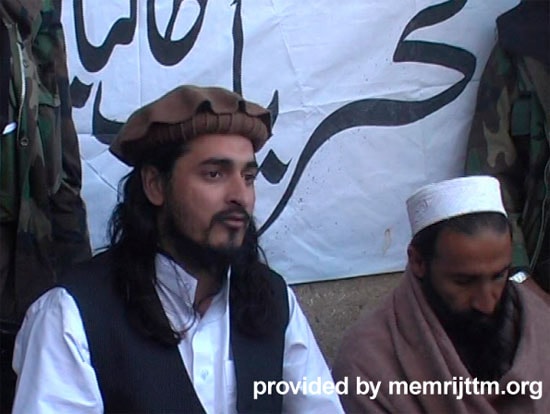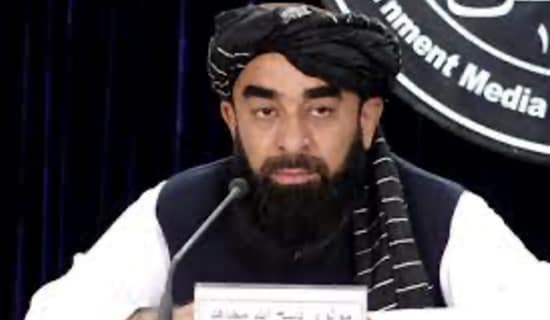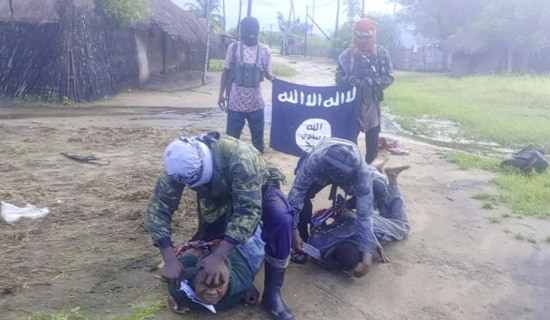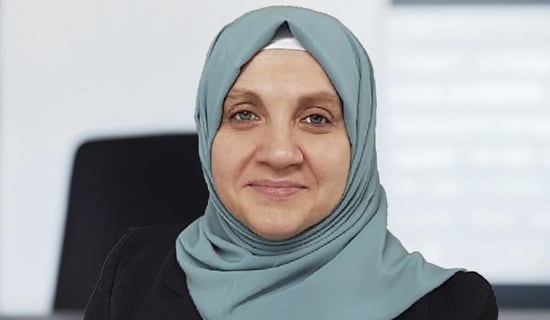
Introduction
On August 7, 2009, Pakistan's Foreign Minister Shah Mahmood Qureshi announced that Taliban commander Baitullah Mehsud, the head of the Pakistani Taliban militants, had been killed in a U.S. drone attack in Pakistan's tribal district of South Waziristan. Quoting Pakistani intelligence sources, Foreign Minister Qureshi, said: "He has been taken out... [But] the government is doing ground verification to confirm 100 percent." [1]
Before Qureshi's announcement, a statement by Rehman Malik, the Pakistani Interior Minister, that there was "strong likelihood" that Baitullah Mehsud, along with his second wife and two bodyguards, was killed in the U.S. missile attack on his father-in-law's house in South Waziristan, sparked speculation as to who would succeed the Taliban chief. [2] The international spotlight has turned on three Taliban commanders, Hakimullah Mehsud (pictured), Waliur Rahman Mehsud, and Azmatullah Mehsud, one of whom could succeed Baitullah Mehsud.
Baitullah Mehsud, the head of militants in South Waziristan tribal district situated along the Afghan border, was named the head of the Tehreek-e-Taliban Pakistan (TTP or Movement of the Pakistani Taliban) in 2007. The TTP was established in December 2007 in an effort to unite various jihadist organizations based in Pakistan.
These jihadist groups had been without an effective central leadership after the U.S. attack on Afghanistan in the wake of the 9/11 attacks. Although the new alliance represented the Pakistani Taliban, its links with the Afghan Taliban, i.e. the militants based in Afghanistan, were always close.
Baitullah Mehsud, who was born in 1974 in Landi Dhok village of Bannu district in Pakistan's North West Frontier Province (NWFP), had forced the Pakistan government to agree ceasefire pacts with him in 2005 and 2007, which helped him emerge stronger than previously thought. At the time of his death, Baitullah Mehsud was thought to be leading nearly 20,000 Taliban militants. [3]
In the years after the 2001 U.S. attack on Afghanistan, a large number of foreign militants moved from Afghanistan to the semi-autonomous tribal districts of Pakistan situated along the Afghan border. On June 28, 2009, Pakistani Interior Minister Rehman Malik noted that Uzbek, Afghan, Arab, Yemeni and Libyan militants had joined the Baitullah Mehsud-led Tehreek-e-Taliban Pakistan. [4]
Baitullah Mehsud's killing has sparked a search for a new Emir of the Tehreek-e-Taliban Pakistan. There are three leading commanders who could possibly succeed Baitullah Mehsud as the new Emir of Tehreek-e-Taliban Pakistan: Hakimullah Mehsud, Waliur Rahman Mehsud and Azmatullah Mehsud. Based in South Waziristan tribal district, all the three are considered close to Baitullah Mehsud.
Hakimullah Mehsud
Hakimullah Mehsud (pictured above), whose real name is Jamshed, has been considered the right hand man of Baitullah Mehsud. Hakimullah Mehsud is in his early 30s and was previously spokesman for Baitullah Mehsud. He is a strong contender to succeed Baitullah Mehsud as the head of the Tehreek-e-Taliban Pakistan. In June this year, Hakimullah Mehsud accused the Pakistani military of waging war against the militants in order to get American dollars, stating: "[We] will fight till the last drop of blood against the military operation in South Waziristan... This is a war to get American dollars." [5]
Waliur Rahman Mehsud
Waliur Rahman Mehsud, who is also in his early 30s, was spokesman for Baitullah Mehsud and is a member of the Taliban's Shura (executive consultative council). He is also considered to be the most learned in Islamic teachings among the militant commanders.
Azmatullah Mehsud
Azmatullah Mehsud, another key Taliban commander who is thought to have been close to Baitullah Mehsud, is also among the possible successors to Baitullah Mehsud. He was wounded in an attack in December 2008. [6]
Qari Hussain and Others
Qari Hussain, another key militant commander whose name figures as the likely successor to Baitullah Mehsud, is considered the Taliban's "chief ideologue" and an expert in training suicide bombers. After an attempt on his life in 2008, Qari Hussain, also in his early 30s, said he was "born to live and serve the Taliban." [7]
There are two more Taliban commanders who have been close to Baitullah Mehsud: Rais Khan and Salim Sakin. [8]
The Next Leader: Can He Fill Baitullah Mehsud's Shoes?
Currently, the strength of Taliban militants in Pakistan is estimated to be nearly 100,000 militants. According to a report, the militant commanders who lead Taliban in tribal districts outside South Waziristan are: Hakimullah Mehsud, in the tribal districts of Orakzai Agency and Kurram Agency, with 8,000 men; Rehmanullah and Hazrat Ali, in Khyber Agency, with 1,200 men; Umar Khalid, in Mohmand Agency, with 5,000 men, and Faqir Muhammad, in Bajaur Agency, with 5,000 fighters. [9] Baitullah was also supported by Tahir Yuldashev's 4,000 Uzbeks and other foreign militants, while the Tehreek-e-Taliban Pakistan could have nearly 50,000 men at its disposal, which totals 100,000 after taking into account non-Baitullah militants. [10]
While Baitullah Mehsud stood out because the militant groups outside South Waziristan district accepted him as their leader, it remains to be seen whether his successor can command respect outside this tribal district. According to a report in a Pakistani website, "while Mehsud's death would be a big blow to the Taliban in Pakistan, he has deputies who could take his place. Whether a new leader could wreak as much havoc as Mehsud depends largely on how much pressure the Pakistani military continues to put on the network, especially in the tribal area of South Waziristan." [11]
Editorial: "The Task for Islamabad is to Prove That It Possesses the Capability and the Commitment to Tackle Mehsud and His Militias"
The killing of Baitullah Mehsud marks a new chapter in the jihadist movement in Pakistan, with a leading Pakistani daily noting that the Taliban chief's death may not essentially lead to the end of militancy. In an editorial, the leading newspaper The News noted: "At present, it is hard to say what direction events are moving in Waziristan...." [12]
The editorial further noted: "The point perhaps to be made is that the U.S. must realize knocking out Mehsud in this fashion could prove counterproductive. There is every possibility this would trigger a surge of sympathy that may undo gains brought about by the death of a key militant figure. One can understand that Washington perhaps feels it has little choice.
"But the task for Islamabad is to prove that it possesses the capability and the commitment to tackle Mehsud and his militias itself. A capture of the man many see as the country's most dangerous terrorist by Pakistani forces, rather than assassination by external agents - particularly U.S. ones - may serve the cause of the wider war on terror more effectively. Militancy in Waziristan may not end with the death of Baitullah Mehsud. A strategy that aims at winning back the agency must be actively pursued by Islamabad." [13]
*Tufail Ahmad is the director of MEMRI's Urdu-Pashtu Media Project.
Endnotes:
[1] www.thearynews.com, Pakistan, August 7, 2009.
[2] The News, Pakistan, August 7, 2009.
[3] Daily Times, Pakistan, August 7, 2009.
[4] Wrazpanra Wahdat, Pakistan, June 29, 2009.
[5] Roznama Nawa-i-Waqt, Pakistan, June 16, 2009.
[6] Daily Times, Pakistan, December 4, 2008.
[7] Daily Times, Pakistan, May 26, 2008.
[8] Daily Times, Pakistan, June 2, 2009. See also MEMRI Jihad and Terrorism Monitor, "Deputy Emir Of Tehreek-e-Taliban Pakistan: '[We] Will Fight Till The Last Drop Of Blood Against The Military Operation In South Waziristan; Pakistani Government’s Claims Of Killing Foreign Militants Are Baseless, '" June 17, 2009.
[9] Daily Times, Pakistan, June 2, 2009.
[10] Daily Times, Pakistan, June 2, 2009.
[11] www.dawn.com, Pakistan, August 7, 2009
[12] The News, Pakistan, August 7, 2009.
[13] The News, Pakistan, August 7, 2009.





